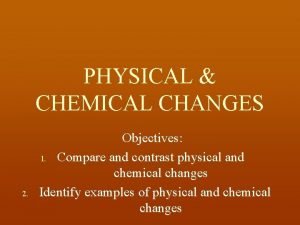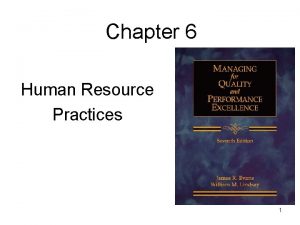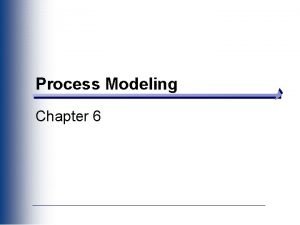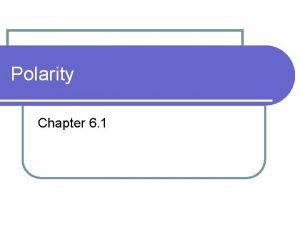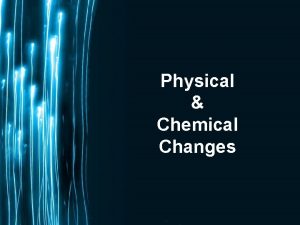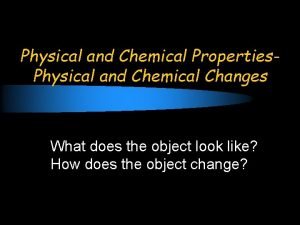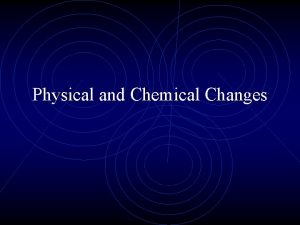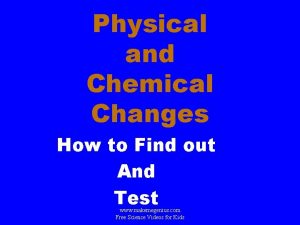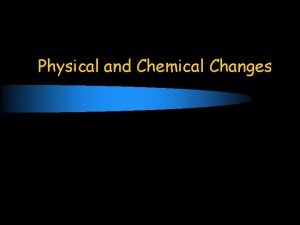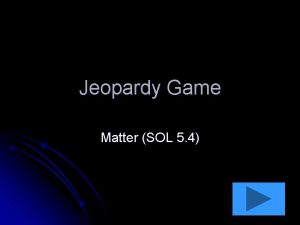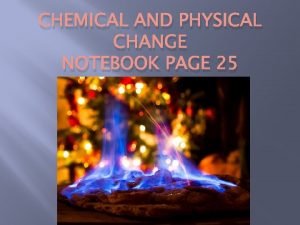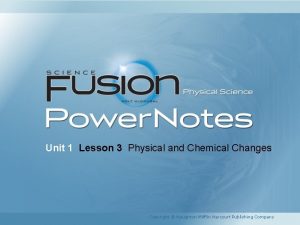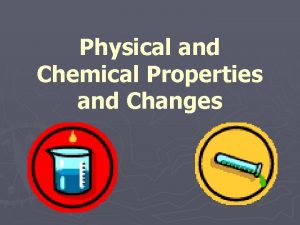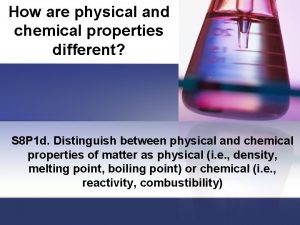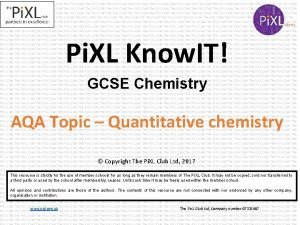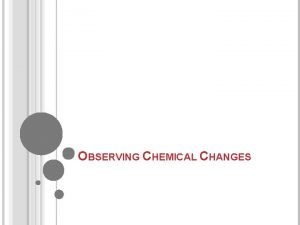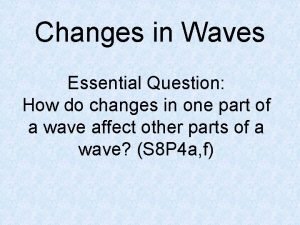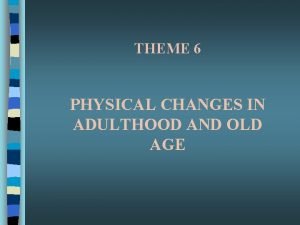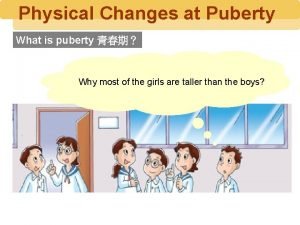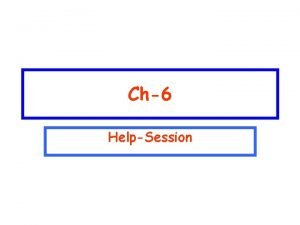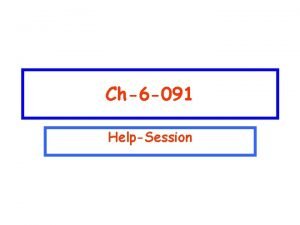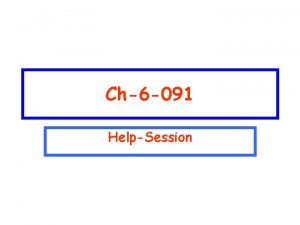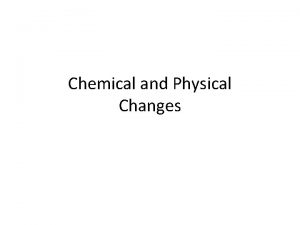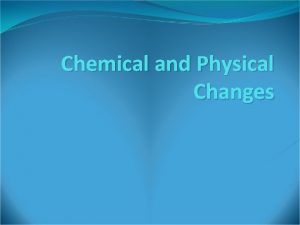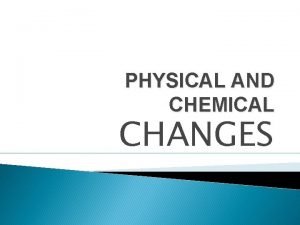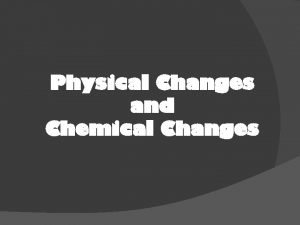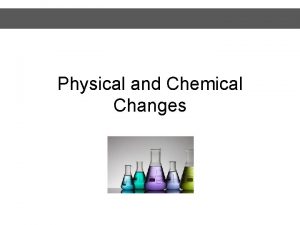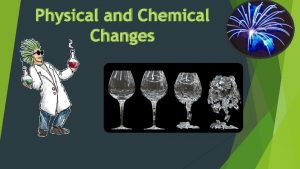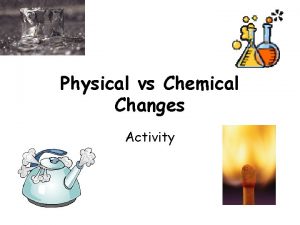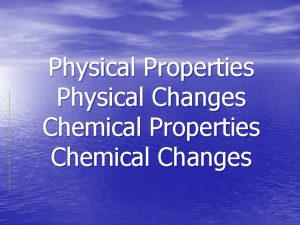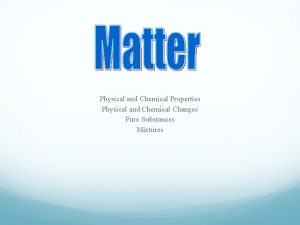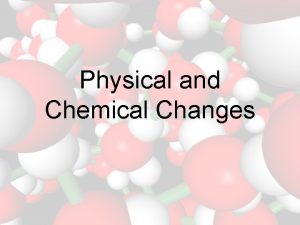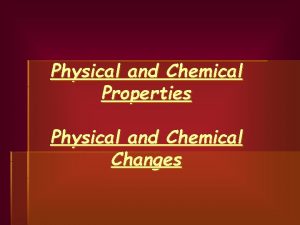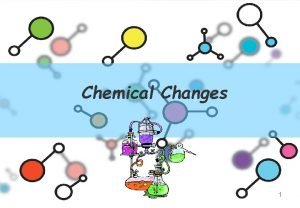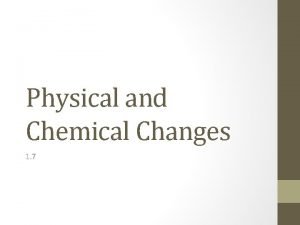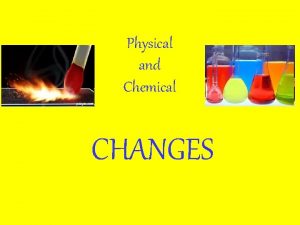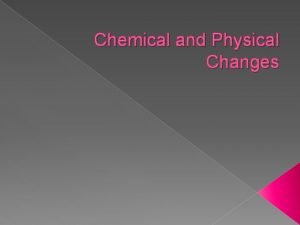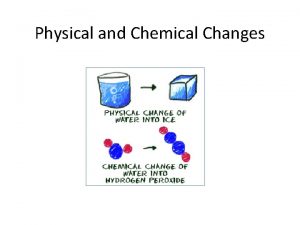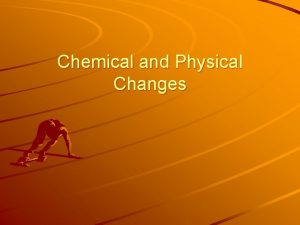Physical and Chemical Changes Ch6 ClassVII Activity 6
































- Slides: 32

Physical and Chemical Changes (Ch-6) Class-VII

Activity 6. 1 • Cut a piece of paper in four square pieces. Cut each square piece further into four square pieces. Lay these pieces on the floor or a table so that the pieces acquire the shape of the original piece of paper Obviously, you cannot join the pieces back to make the original piece, but is there a change in the property of the paper?


Activity 6. 2 • Collect the chalk dust lying on the floor near the blackboard in your classroom. Or, crush a small piece of chalk into dust. Add a little water to the dust to make a paste. Roll it into the shape of a piece of chalk

Activity 6. 3 • Take some ice in a glass or plastic tumbler. Melt a small portion of ice by placing the tumbler in the sun. You have now a mixture of ice and water. Now place the tumbler in a freezing mixture • (ice plus common salt). • Does the water become solid ice once again?

Activity 6. 4 • Boil some water in a container. Do you see the steam rising from the surface of water? Hold an inverted pan by its handle over the steam at some distance from the boiling water. Observe the inner surface of the pan. • Do you see any droplet of water there?

Activity 6. 5 • Hold a used hack-saw blade with a pair of tongs. Keep the tip of the free end on the flame of a gas stove. Wait for a few minutes. • Does the colour of the tip of the blade change? • Remove the blade from the flame. • Observe the tip once again after some time. • Does it get back its original colour?

Physical properties • Properties such as shape, size, colour and state of a substance are called its physical properties. • A physical change is generally reversible. • In such a change no new substance is formed.

Activity 6. 6 • . Get a small piece of a thin strip or ribbon of magnesium. Clean its tip with sandpaper. Bring the tip near a candle flame. It burns with a brilliant white light. When it is completely burnt it leaves behind a powdery ash. • Does the ash look like the magnesium ribbon? • The change can be represented by the following equation: • Magnesium (Mg) + Oxygen (O 2) → Magnesium oxide (Mg. O)

Activity 6. 6 • On dissolving the ash in water it forms a new substance. • This change can be written in the form of the following equation: • Magnesium oxide (Mg. O) + Water (H 2 O) → Magnesium hydroxide [Mg(OH)2]

Activity 6. 7 • Dissolve about a teaspoonful of coppersulphate (blue vitriol or neela thotha) inabout half a cup of water in a glass tumbler or a beaker. Add a few drops ofdilute sulphuric acid to the solution. • Copper Sulphate solution (blue) + Iron → Iron Sulphate solution (green) + Copper (brown deposit)


Activity 6. 8 • Take about a teaspoonful of vinegar in a test tube. Add a pinch of baking soda to it. You would hear a hissing sound and see bubbles of a gas coming out. Pass this gas through freshly prepared lime water. • What happens to the lime water?


Chemical change • A change in which one or more new substances are formed is called a chemical change. • Example: -When food gets spoiled, it produces a foul smell.

The following points may accompany a chemical change 1. Heat, light or any other radiation (ultraviolet, for example) may be given off or absorbed. 2. Sound may be produced. 3. A change in smell may take place or a new smell may be given off. 4. A colour change may take place. 5. A gas may be formed.

(Rusting) • If we leave a piece of iron in the open for some time, it acquires a film of brownish substance. This substance is called rust and the process is called rusting • For rusting, the presence of both oxygen and water (or water vapour) is essential.


Galvanisation: -Deposit a layer of a metal like chromium or zinc on iron. This process of depositing a layer of zinc on iron is called galvanisation. CRYSTALLISATION : - large crystals of pure substances can be formed from their solutions. The process is called crystallisation. It is an example of a physical change.

1. Classify the changes involved in the following processes as physical or chemical changes Answer (a) Photosynthesis → Chemical change (b) Dissolving sugar in water → Physical change (c) Burning of coal → Chemical change (d) Melting of wax → Physical change (e) Beating aluminium to make aluminium foil → Physical change (f) Digestion of food → Chemical change

2. State whether the following statements are true or false. In case a statement is false, write the corrected statement in your notebook. • (a) Cutting a log of wood into pieces is a chemical change. (True/False) (b) Formation of manure from leaves is a physical change. (True/False) • (c) Iron pipes coated with zinc do not get rusted easily. (True/False) (d) Iron and rust are the same substances. (True/False) (e) Condensation of steam is not a chemical change. (True/False)

3. Fill in the blanks in the following statements: • (a) When carbon dioxide is passed through lime water, it turns milky due to the formation of _____. (b) The chemical name of baking soda is _____. (c) Two methods by which rusting of iron can be prevented are _____ and _____. (d) Changes in which only _____ properties of a substance change are called physical changes. (e) Changes in which new substances are formed are called _____ changes.

3. Fill in the blanks in the following statements: (a) calcium carbonate (Ca. CO 3). (b) sodium hydrogen carbonate (Na. HCO 3). (c) galvanization , painting. (d) physical (e) Chemical

4. When baking soda is mixed with lemon juice, bubbles are formed with the evolution of a gas. What type of change is it? Explain. • Answer When baking soda is mixed with lemon juice, the bubbles which are formed with the evolution of a gas is due to the evolution of carbon dioxide gas. Since, there is formation of a new substance in this reaction, it is a chemical change.

5. When a candle burns, both physical and chemical changes take place. Identify these changes. Give another example of a familiar process in which both the chemical and physical changes take place. Answer When a candle burns, both physical and chemical changes take place. The melting wax is physical change as there is no formation of new product. The burning of wax is chemical change as light is lit up by consuming the energy from wax. Cooking of food is both physical and chemical because raw vegetables get cooked which is a chemical change and the water changes into steam which is a physical change.

6. How would you show that setting of curd is a chemical change? Answer Curd is formed it cannot be reversed back into milk. So, there is formation of new substance with different properties and also an irreversible process, setting of curd is a chemical change.

7. Explain why burning of wood and cutting it into small pieces are considered as two different types of changes. Answer When we burn wood, it turns into ashes which is a new substance and process is irreversible one, hence is a chemical change. While cutting the wood into small pieces no new substance is formed, hence is a physical change

8. Describe how crystals of copper sulphate are prepared. Answer Crystals of copper sulphate are prepared by the method of crystallization. The process is as followed: Step 1: A cupful of water in a beaker is taken. Step 2: Few drops of dilute sulphuric acid is added to it. Step 3: Water is heated and when it starts boiling copper sulphate powder is added slowly while stirring till no more copper sulphate powder dissolved in it. Step 4: Solution is filtered and let it cool without disturbance. After some time the crystals of copper can be observed in it.

9. Explain how painting of an iron gate prevents it from rusting. Answer Painting of an iron gate prevents it from rusting because it cut the direct contact of iron from the environment and therefore there is no further exposure of iron to oxygen in moisture which is the causes for rusting.

10. Explain why rusting of iron objects is faster in coastal areas than in deserts. Answer Iron objects get rusted because of the reaction with oxygen present in moist air. In coastal areas, the presence of moisture is more because of sea or ocean while in deserts the air is dry and hot. Therefore, rusting of iron objects is faster in coastal areas than in deserts due to presence of moisture

11. The gas we use in the kitchen is called liquified petroleum gas (LPG). In the cylinder it exist as a liquid. When it comes out from the cylinder it becomes a gas (Change–A) then it burns (Change–B). The following statements pertain to these changes. Choose the correct one. (i) Process – A is a chemical change. (ii) Process – B is a chemical change. (iii) Both processes A and B are chemical changes. (iv) None of these processes is a chemical change. Answer (ii) Process – B is a chemical change.

12. Anaerobic bacteria digest animal waste and produce biogas (Change –A). The biogas is then burnt as fuel (Change –B). The following statements pertain to these changes. Choose the correct one. (i) Process – A is a chemical change. (ii) Process – B is a chemical change. (iii) Both processes A and B are chemical changes. (iv) None of these processes is a chemical change. Answer (iii) Both processes A and B are chemical changes.
 Meaning of physical change
Meaning of physical change Compare and contrast physical and chemical changes
Compare and contrast physical and chemical changes Toyota ch6
Toyota ch6 Dfd fragments
Dfd fragments Bond polarity definition
Bond polarity definition Physical change
Physical change Physical and chemical changes
Physical and chemical changes Is sawing wood a chemical change
Is sawing wood a chemical change Generation genius physical and chemical changes
Generation genius physical and chemical changes Physical l change
Physical l change Physical change
Physical change Difference between a chemical and physical change
Difference between a chemical and physical change Lesson 3 physical and chemical changes answers
Lesson 3 physical and chemical changes answers Physical change and chemical change venn diagram
Physical change and chemical change venn diagram Physical and chemical changes jeopardy
Physical and chemical changes jeopardy Chemical change in baking
Chemical change in baking Chemical change
Chemical change Physical changes lesson 3 outline
Physical changes lesson 3 outline True or false: chemical and physical changes alter matter.
True or false: chemical and physical changes alter matter. Lesson 1 thermal energy and the behavior of matter
Lesson 1 thermal energy and the behavior of matter Chemical reactions section 1 chemical changes
Chemical reactions section 1 chemical changes Physical/chemical changes & properties color by number
Physical/chemical changes & properties color by number Chemical properties of air
Chemical properties of air Physical and chemical properties sorting activity
Physical and chemical properties sorting activity What is physical fitness test in mapeh
What is physical fitness test in mapeh Changes in latitudes, changes in attitudes meaning
Changes in latitudes, changes in attitudes meaning Chemical properties and changes lesson 4
Chemical properties and changes lesson 4 Pixl knowit gcse chemistry chemical changes
Pixl knowit gcse chemistry chemical changes What are the five chemical changes
What are the five chemical changes Observing chemical change
Observing chemical change Changes in wave properties sorting activity answer key
Changes in wave properties sorting activity answer key Physical changes of old age
Physical changes of old age Physical changes in female during puberty
Physical changes in female during puberty

